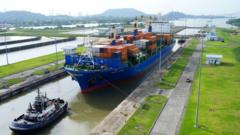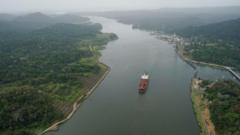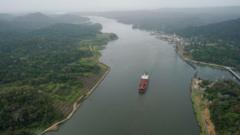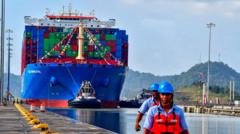As the Panama Canal adapts to accommodate larger cargo ships, researchers are observing an alarming shift in aquatic ecosystems, with invasive species threatening local biodiversity.**
Ecological Shift in the Panama Canal: A New Wave of Marine Invasion**

Ecological Shift in the Panama Canal: A New Wave of Marine Invasion**
The expansion of the Panama Canal is allowing species from the Atlantic and Pacific Oceans to intermingle, raising ecological concerns.**
The Panama Canal, a vital link for global trade, is undergoing an ecological transformation due to its recent expansion to facilitate larger shipping vessels. This major infrastructure change has opened the gates for marine species from the Atlantic and Pacific Oceans to mingle in ways previously unseen since the isthmus of Panama emerged three million years ago, creating significant ecological implications.
Recent studies initiated by the Smithsonian Tropical Research Institute have unveiled that a host of saltwater fish, including snooks, jacks, and snappers, are rapidly displacing native freshwater species like tilapia and peacock bass within the canal's ecosystem. Fishermen operating around Lake Gatún report dwindling catches, highlighting the immediate economic ramifications for local communities reliant on these freshwater fish.
Moreover, scientists express concerns about increasingly invasive species, particularly the lionfish. These venomous predators, native to the Caribbean, have not penetrated the eastern Pacific but could potentially thrive if they journey through the newly accessible canal. The introduction of lionfish to an unprepared environment could have dire consequences for local fish populations, mirroring their destructive impact in the Gulf of Mexico and the Caribbean.
As these changes unfold, the interaction between global trade and local ecosystems is foregrounding questions about sustainability and conservation efforts. The Panama Canal, a symbol of human ingenuity in maritime navigation, now stands at the epicenter of a critical ecological evolution, underscoring the need for comprehensive studies and strategies to mitigate potentially devastating environmental impacts.
Recent studies initiated by the Smithsonian Tropical Research Institute have unveiled that a host of saltwater fish, including snooks, jacks, and snappers, are rapidly displacing native freshwater species like tilapia and peacock bass within the canal's ecosystem. Fishermen operating around Lake Gatún report dwindling catches, highlighting the immediate economic ramifications for local communities reliant on these freshwater fish.
Moreover, scientists express concerns about increasingly invasive species, particularly the lionfish. These venomous predators, native to the Caribbean, have not penetrated the eastern Pacific but could potentially thrive if they journey through the newly accessible canal. The introduction of lionfish to an unprepared environment could have dire consequences for local fish populations, mirroring their destructive impact in the Gulf of Mexico and the Caribbean.
As these changes unfold, the interaction between global trade and local ecosystems is foregrounding questions about sustainability and conservation efforts. The Panama Canal, a symbol of human ingenuity in maritime navigation, now stands at the epicenter of a critical ecological evolution, underscoring the need for comprehensive studies and strategies to mitigate potentially devastating environmental impacts.






















